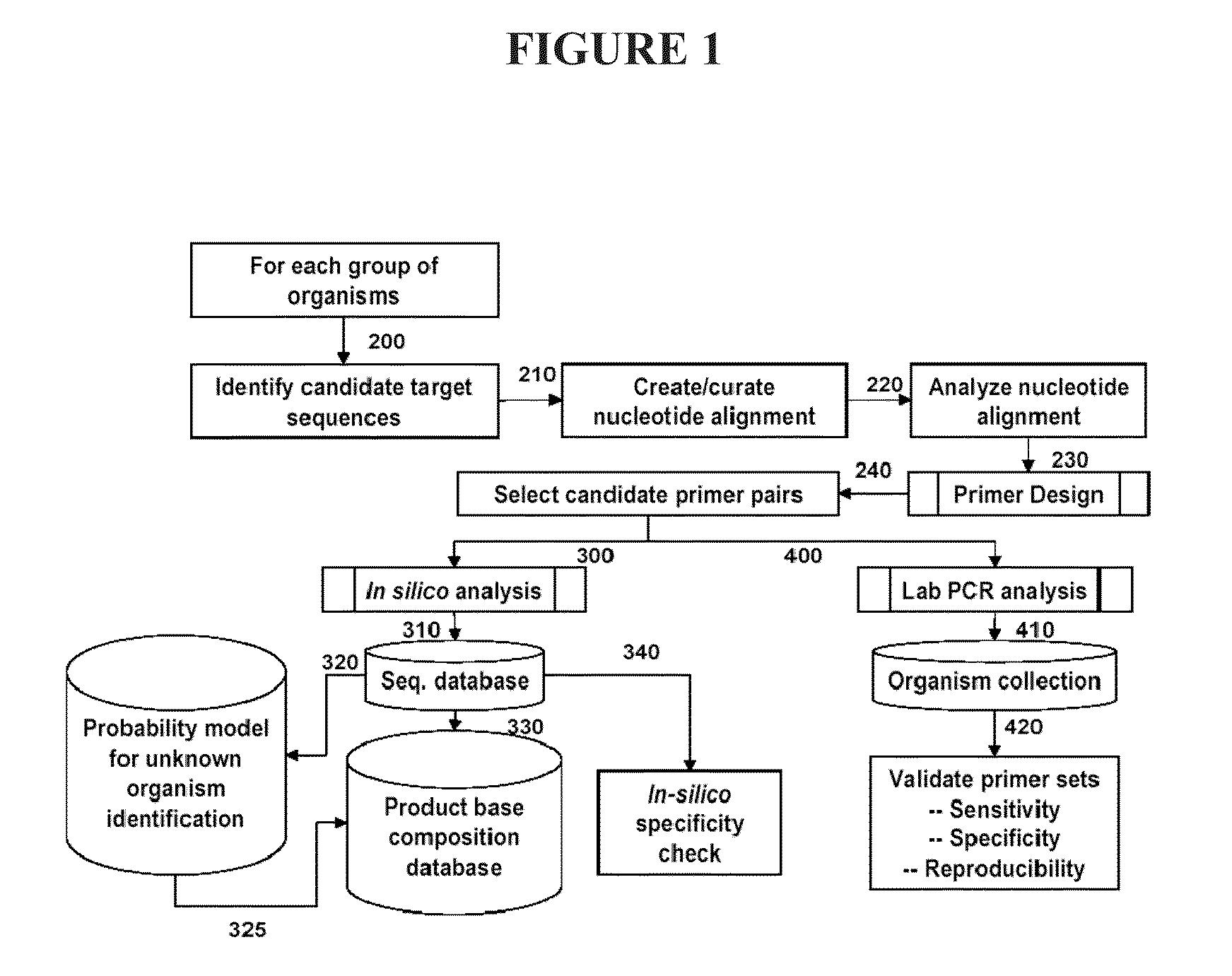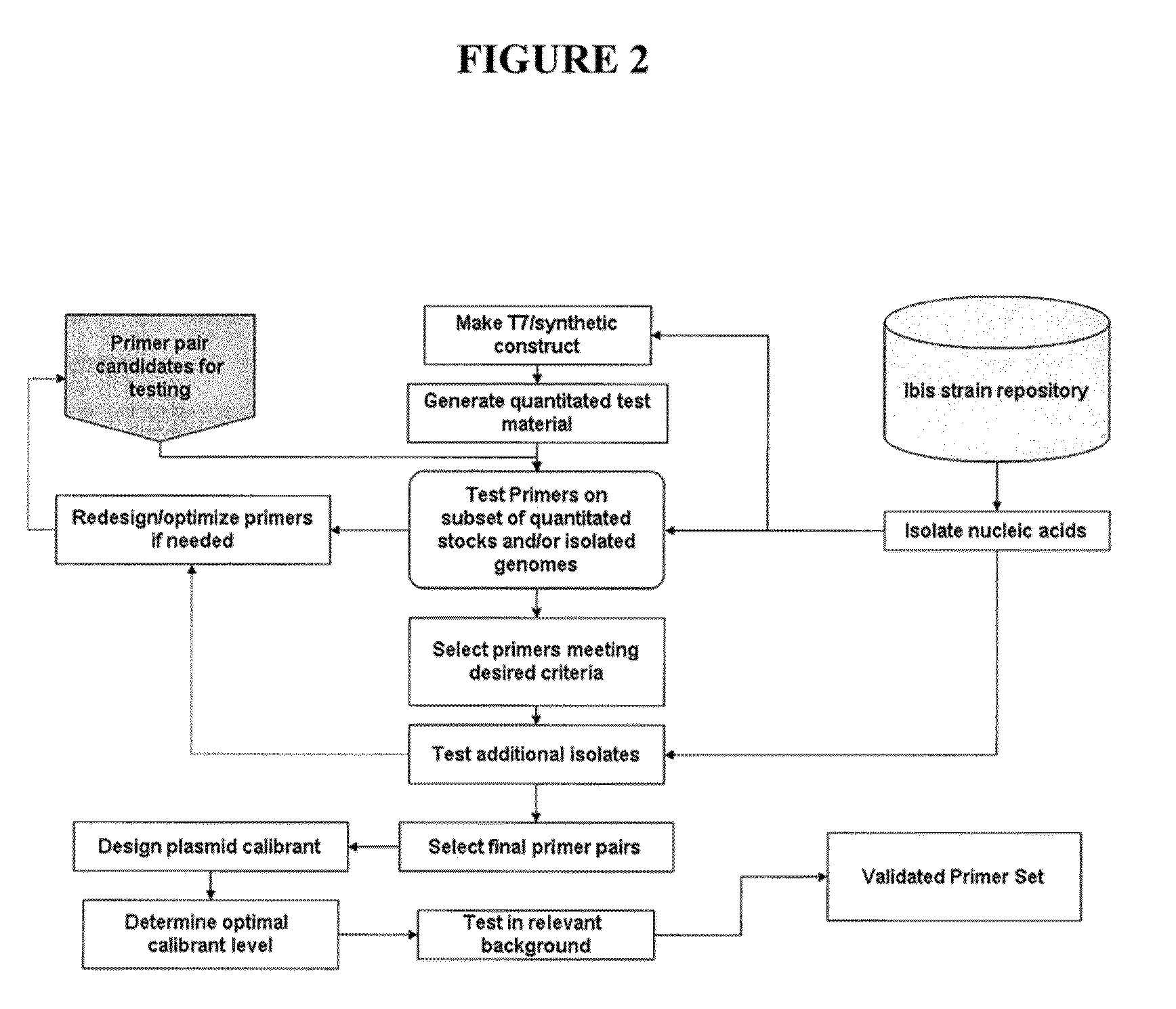Compositions for use in identification of pseudomonas aeruginosa
a technology of compositions and pseudomonas aeruginosa, applied in the field of identification of pseudomonas aeruginosa, can solve the problems of laborious and slow conventional methods for characterizing these organisms
- Summary
- Abstract
- Description
- Claims
- Application Information
AI Technical Summary
Benefits of technology
Problems solved by technology
Method used
Image
Examples
example 1
High-Throughput ESI-Mass Spectrometry Assay for the Identification of Pseudomonas aeruginosa
[0117]This example describes a Pseudomonas aeruginosa (PA) pathogen identification investigation which employed mass spectrometry determined base compositions for PCR amplicons derived from Pseudomonas aeruginosa. This investigation used the Isis T5000 Biosensor System device for determining base compositions. The T5000 Biosensor System is a mass spectrometry based universal biosensor that uses mass measurements to derived base compositions of PCR amplicons to identify bioagents including, for example, bacteria, fungi, viruses and protozoa (S. A. Hofstadler et. al. Int. J. Mass Spectrom. (2005) 242:23-41, herein incorporated by reference). The T5000 Biosensor System was used to generate base composition data for this study thereby allowing comparison to known base compositions (e.g., from PA) such that PA and PA strains can be identified.
[0118]A PA outbreak investigation was conducted betwee...
example 2
[0144]De Novo Determination of Base Composition of Amplicons using Molecular Mass Modified Deoxynucleotide Triphosphates
[0145]Because the molecular masses of the four natural nucleobases fall within a narrow molecular mass range (A=313.058, G=329.052, C=289.046, T=304.046, values in Daltons—See, Table 5), a source of ambiguity in assignment of base composition may occur as follows: two nucleic acid strands having different base composition may have a difference of about 1 Da when the base composition difference between the two strands is GA (−15.994) combined with CT (+15.000). For example, one 99-mer nucleic acid strand having a base composition of A27G30C21T21 has a theoretical molecular mass of 30779.058 while another 99-mer nucleic acid strand having a base composition of A26G31C22T20 has a theoretical molecular mass of 30780.052 is a molecular mass difference of only 0.994 Da. A 1 Da difference in molecular mass may be within the experimental error of a molecular mass measureme...
example 3
High-Throughput ESI-Mass Spectrometry Assay for the Identification of Pseudomonas aeruginosa
[0154]This example describes a Pseudomonas pathogen identification assay which employs mass spectrometry determined base compositions for PCR amplicons derived from herpesvirus. The T5000 Biosensor System is a mass spectrometry based universal biosensor that uses mass measurements to derived base compositions of PCR amplicons to identify bioagents including, for example, bacteria, fungi, viruses and protozoa (S. A. Hofstadler et. al. Int. J. Mass Spectrom. (2005) 242:23-41, herein incorporated by reference). For this Pseudomonas assay primers from Tables 1 and 6 may be employed to generate PCR amplicons. The base composition of the PCR amplicons can be determined and compared to a database of known Pseudomonas base compositions to determine the identity of a Pseudomonas in a sample. Tables 1 and 6 show exemplary primers pairs for detecting Pseudomonas.
TABLE 6APrimer SequencesPrimerPrimerSEQ ...
PUM
| Property | Measurement | Unit |
|---|---|---|
| Fraction | aaaaa | aaaaa |
| Volume | aaaaa | aaaaa |
| Mass | aaaaa | aaaaa |
Abstract
Description
Claims
Application Information
 Login to View More
Login to View More - R&D
- Intellectual Property
- Life Sciences
- Materials
- Tech Scout
- Unparalleled Data Quality
- Higher Quality Content
- 60% Fewer Hallucinations
Browse by: Latest US Patents, China's latest patents, Technical Efficacy Thesaurus, Application Domain, Technology Topic, Popular Technical Reports.
© 2025 PatSnap. All rights reserved.Legal|Privacy policy|Modern Slavery Act Transparency Statement|Sitemap|About US| Contact US: help@patsnap.com



